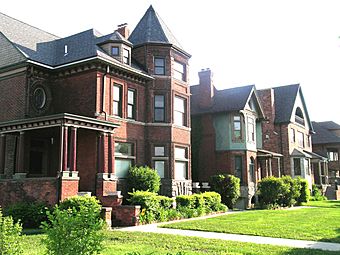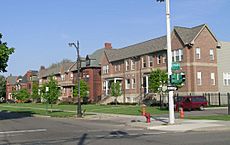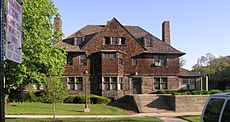East Ferry Avenue Historic District facts for kids
|
East Ferry Avenue Historic District
|
|

East Ferry streetscape
|
|
| Location | Detroit, Michigan, U.S. |
|---|---|
| Architect | Multiple |
| Architectural style | Châteauesque, Colonial Revival, Queen Anne, Romanesque Revival, Shingle |
| NRHP reference No. | 80001921 |
Quick facts for kids Significant dates |
|
| Added to NRHP | March 10, 1980 |
The East Ferry Avenue Historic District is a special neighborhood in Midtown Detroit, Michigan. It's known for its beautiful old homes. This historic area stretches for two blocks from Woodward Avenue to Brush Street. There's also a third block that's important locally, going to Beaubien Street. Some famous houses, like the Col. Frank J. Hecker House and the Charles Lang Freer House, are part of this district. It was recognized as a Michigan State Historic Site in 1976. Later, in 1980, it was added to the National Register of Historic Places, which means it's important for the whole country.
The Inn on Ferry Street, a charming place to stay, is part of a group called Historic Hotels of America. This group works with the National Trust for Historic Preservation to protect old buildings.
History of East Ferry Avenue
In 1856, a company called Ferry Seed Company started in Detroit. They had a big farm at East Ferry and Woodward Avenue. This farm grew seeds that were sold all over the country.
Around the mid-1880s, the owner, D. M. Ferry, divided the farm into smaller plots. These plots became lots for houses along East Ferry Avenue. At that time, Woodward Avenue was a very fancy street with expensive homes. So, the lots facing Woodward were quite costly.
Lots on the side streets, like East Ferry, were more affordable. Soon, many successful middle and upper-middle-class families moved to East Ferry. Some important early residents included Col. Frank J. Hecker, a military leader and business owner. His partner, Charles Lang Freer, was a famous art collector. Other residents included William A. Pungs, who started a car company, and John Scott, a well-known architect.
Over time, Woodward Avenue changed to mostly businesses. But the beautiful mansions and nice homes on East Ferry stayed. Around World War I, many professionals and business people bought homes there. The Omega Psi Phi fraternity and the Lewis College of Business are still on East Ferry today.
After World War II, the Merrill Palmer Institute bought several homes on East Ferry. They hoped to grow their programs. But they couldn't expand as planned. In the late 1960s, they sold the homes to the Detroit Institute of Arts (DIA). The DIA wanted to use the land for their own expansion.
However, the DIA later realized the East Ferry properties wouldn't work for them. So, in the mid-1990s, they sold the homes again. Four of these homes became The Inn on Ferry Street, a popular bed and breakfast. Other homes are now private residences. Recently, new homes have been built in the area. They are designed to look like the older 19th-century houses.
What the Homes Look Like
The houses on East Ferry are built close together on smaller lots. They are set back a bit from the street. Many of them still have their original carriage houses, which were like garages for horses and carriages.
Most homes in the neighborhood are in the Queen Anne style. They are often made of brick and sandstone. You can spot them by their bay windows or round towers (turrets) and wide front porches. There are also some homes built in the Romanesque Revival and Colonial Revival styles.
The homes on East Ferry are great examples of residential designs from Detroit's top 19th-century architects. These include famous names like John Scott, Louis Kamper, Malcomson and Higginbotham, and Smith, Hinchman & Grylls.
Gallery
See also
 In Spanish: Distrito Histórico de East Ferry Avenue para niños
In Spanish: Distrito Histórico de East Ferry Avenue para niños





